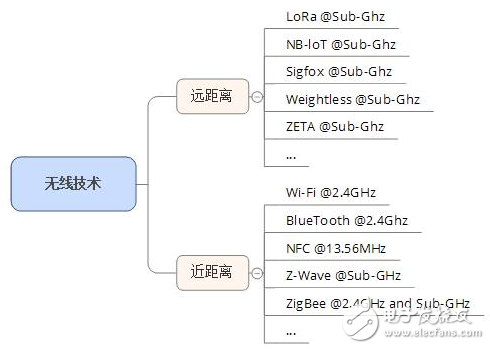The demand for IoT business is huge, and it has obvious vertical industry characteristics, which is also one of the hot concepts in the current market. IoT technology can be subdivided into fixed or slow wireless data access (local area Internet of things), mobile wireless data access (mobile Internet of things), and ubiquitous wireless data access (low-power wide-area Internet of Things) based on business scenarios. three conditions. If we divide wireless technology according to the distance of transmission distance, our common Internet of Things technology can be divided into long-distance communication and near-field communication IoT technology, which are roughly classified as follows:

LoRa, China's LoRa Application Alliance (CLAA) recommends 470-510MHz. The main frequency ranges in other regions are as follows:

NB-IoT, the world's mainstream frequency bands are 800MHz and 900MHz. China Telecom will use 800MHz as the preferred frequency band for deploying NB-IoT. China Unicom will choose 900MHz to deploy NB-IoT. China Mobile may re-cultivate the existing 900MHz frequency band. The main frequencies of NB-IoT worldwide are shown in the following table:

Sigfox, Europe, Middle East: 868MHz (ETSI 300220), North America: 902MHz (FCC part 15), South America/Australia/New Zealand: 920MHz (ANATEL 506, AS/NZS 4268).

Weightless, an open standard LPWAN wireless technology, operates over the entire unlicensed Sub-GHz ISM/SRD band and can be deployed globally: 169/433/470/780/868/915/923MHz.
Wi-Fi and Bluetooth Bluetooth are commonly deployed in the 2.4 GHz ISM public band. For other WIFI standards and frequencies, refer to the following table:

Bluetooth
2400 to 2483.5 (MHz)
NFC, it is reported that the Ministry of Industry and Information Technology will release the near field communication technology standard based on 13.56MHz. The NFC and RFID bands in other regions refer to the following table:
NFC, RFID
125 kHz to 134 kHz
6.7 MHz
13.56 MHz (NFC)
27 MHz
433 MHz
865 MHz to 868 MHz (Europe)
902 MHz to 928 MHz (North America)
5.8 GHz
2.45 GHz
24.125 GHz
Z-Wave, which operates in China at 868.40 MHz, complies with the ETSI/EN 300 220 standard.
ZigBee, Thread, ISA100.11a and other specifications are extended based on IEEE 802.15.4. The frequency used by general IEEE 802.15.4 devices is 868/915/2400MHz. The specific frequency reference is as follows:
ZigBee/Thread/ 6LoWPAN (IEEE 802.15.4)
169.4 to 169.475 MHz
250 to 750 MHz
779 to 787 MHz
863 to 879 MHz
896 to 960 MHz
1427 to 1518 MHz
2360 to 2483.5 MHz
3244 to 4742 MHz
5944 to 10234 MHz
ZigBee 3.0, Thread, 6LoWPAN
2360 to 2483.5 MHz
The above is the common Internet of Things technology and corresponding frequency band information compiled by Skylabs in combination with the current public data. It may inevitably be missed or even wrong, so the information in this article is for reference only. For the frequency band division of specific countries, please refer to the latest information of ITU.
Beam Lights,Beam Moving Head Lights,Moving Head Beam, Beam 7R
Guangzhou Cheng Wen Photoelectric Technology Co., Ltd. , https://www.stagelightcw.com
